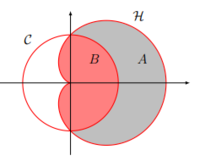Hi, in preparations of my calculus exam I have been making exams of the previous years, but I've tried the next question twice but fail to get the right answer. the problem goes as follows:

circle c: x² + y² = 1
the heart shape has a corresponding equation of (x-1/2)² + y² -sqrt(x²+y²) = 1/4
a) transform both functions to polar coordinates.
b) find the volume of the body enclosed vertically by the planes z=0 and z=4 and horizontally enclosed by the edge of the gray colored area A.
c) find the volume of the body enclosed vertically by the planes z=0 and z=4 and horizontally enclosed by the edge of the red colored area B.
For part a I get r² = 1 and r²cos²a - r*cos a +r²sin²a - r = 0 with a being the angle
for part b i'm not even sure I know which area he wants me to calculate. I think area B but i'm not sure. but when I try to integrate ( Z from 0-4, r from 0 - sqrt1 and a from 0 to 2pi) I get a volume of zero. I assume the a needs to be a different value but I'm not sure which that would be. the supposed right answer is 8+pi
for part C i would calculate the overall volume of the cylinder C and subtract the answer from B but I can't really verify without solving B first.
Many thanks
-Maxim

circle c: x² + y² = 1
the heart shape has a corresponding equation of (x-1/2)² + y² -sqrt(x²+y²) = 1/4
a) transform both functions to polar coordinates.
b) find the volume of the body enclosed vertically by the planes z=0 and z=4 and horizontally enclosed by the edge of the gray colored area A.
c) find the volume of the body enclosed vertically by the planes z=0 and z=4 and horizontally enclosed by the edge of the red colored area B.
For part a I get r² = 1 and r²cos²a - r*cos a +r²sin²a - r = 0 with a being the angle
for part b i'm not even sure I know which area he wants me to calculate. I think area B but i'm not sure. but when I try to integrate ( Z from 0-4, r from 0 - sqrt1 and a from 0 to 2pi) I get a volume of zero. I assume the a needs to be a different value but I'm not sure which that would be. the supposed right answer is 8+pi
for part C i would calculate the overall volume of the cylinder C and subtract the answer from B but I can't really verify without solving B first.
Many thanks
-Maxim
